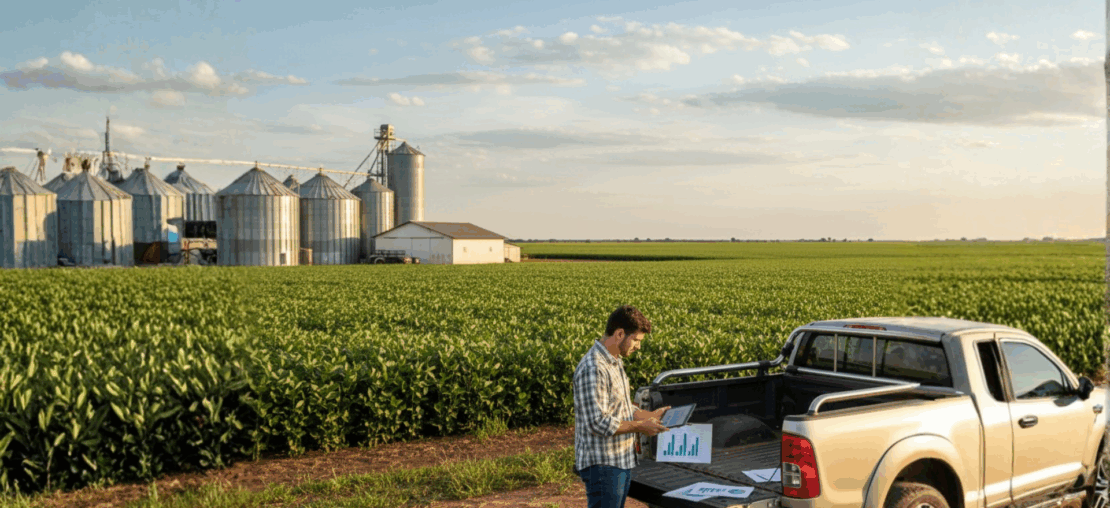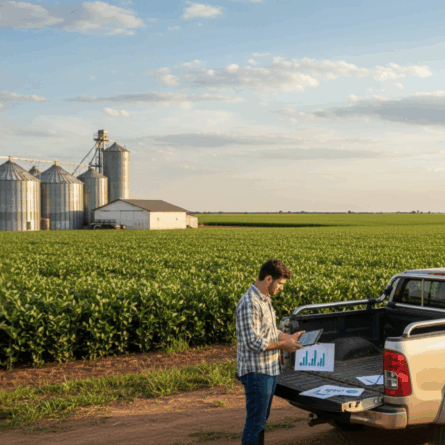Executive summary: Tax Reform (CA 132/2023) preserves strategic incentives for agribusiness but forces an urgent review of contracts, logistics chains, and credit management. Companies that structure cost spreadsheets by value chain, revise barter agreements, and implement tax governance will be able to protect margins through 2033.
📋 Índice
- → What changes for agribusiness with the Tax Reform
- → Impact by value chain
- → Summary simulation (per ton of soy)
- → Strategies to protect margins
- → Updated contract models
- → Chain-specific cost spreadsheet (download)
- → Compliance and governance after the reform
- → Case studies
- → Frequently asked questions
- → Next steps
- → Legal and technical references
Market benchmark: Reports from CNA (2025) and analyses by firms such as Tax Group and Migalhas highlight cost pressures on fertilizers and the need to revisit Basic Productive Processes (PPB). This article goes further by delivering cost worksheets, contract templates, and step-by-step operational checklists.
What changes for agribusiness with the Tax Reform
CA 132/2023 maintains differentiated treatment for agribusiness: strategic inputs will have a 60% rate reduction and staples will remain tax-free. Details, however, hinge on PLP 68/2024 (CBS) and state regulations for IBS. Between 2026 and 2033 the current taxes and CBS/IBS will coexist—forcing dual bookkeeping and PPB adjustments.
Essential timeline
| Phase | Milestone | Critical actions |
|---|---|---|
| 2024 | Approval of complementary bills 68/2024 and 108/2024 | Track lists of reduced-rate products, update NCM catalogs |
| 2025 | Definition of sector-specific credits and incentives | Align cost spreadsheets and barter contracts |
| 2026 | CBS/IBS pilot at 1% | Parameterize ERP, test simulations, record credits |
| 2027-2033 | Rate escalation | Adjust pricing, revisit state incentives, monitor margins |
Sources: CA 132/2023; CNA Technical Note 01/2025; MAPA – Agribusiness Tax Bulletin (Mar 2025); CNI report “Impacts of the Reform on Agribusiness” (Feb 2025).
Impact by value chain
| Chain | Opportunities | Risks |
|---|---|---|
| Grains (soy, corn) | Expanded credits on inputs (seeds, fertilizers, logistics); exports remain tax-free | Robust documentation required to keep ICMS presumed credit (RE 784439) |
| Animal protein | Ability to offset feed and energy costs; integration with drawback | Greater scrutiny over byproducts and contracts with slaughterhouses |
| Fertilizers & crop protection | Rate adjustments with a 60% reduction | Possible initial price hikes and currency pressure |
Competitive comparison: Gov.br provides only brief notes about sector incentives, while firms such as Keevo and Windel issue generic warnings about repricing. Here we break down the variations by value chain and supply a spreadsheet with currency and tax sensitivity. Recommended tools: reconciliation dashboards, RPA to cross-check e-invoices and bank statements, and ERP integrations. Consider deploying alerts similar to those used by cooperatives in the Agribusiness Tax Bulletin (Mar 2025), which reported a 25% reduction in response time to state audits.
Summary simulation (per ton of soy)
- Current cost: R$ 1,250 (inputs + logistics) with limited PIS/Cofins credits.
- CBS/IBS scenario: full financial credit → R$ 40–60/ton savings.
- Recommendation: allocate the savings to currency hedging and stronger compliance documentation.
Additional example: CNA’s Feb 2025 study indicates that cooperatives aligning barter + hedging reduced margin volatility by 3 percentage points at the peak of the 2024/2025 harvest. Use that metric when renegotiating contracts.
Strategies to protect margins
- Credit documentation: consolidate invoices, technical reports, and logistics evidence in a single data room.
- Special regimes: combine drawback, RECAP, and ALADI with CBS/IBS; review inventory and outstanding special-regime balances.
- Contract renegotiation: add automatic pass-through clauses, adjustment triggers, and margin indicators.
- Currency hedging: align tax gains with NDF/options hedging strategies to offset fertilizer volatility.
Updated contract models
- Barter agreements: insert tax-adjustment clauses, CBS/IBS indicators, and seasonal price reviews.
- Distributor agreements: include credit pass-through, adjusted payment terms, and documentation duties.
- Cooperative vs. members: define profit-sharing rules that incorporate the new credits.
CTA: Request the CBS/IBS Agribusiness Contract Template with updated clauses.
Chain-specific cost spreadsheet (download)
The “Agro Costs vs. CBS/IBS” workbook has three tabs (grains, protein, fertilizers) with the following fields:
- Production volume, variable/fixed costs, logistics expenses.
- Current vs. estimated CBS/IBS rate, available credits, EBITDA impact.
- Sensitivity analysis (currency, input prices, freight).
How to use it:
- Enter historical data by crop and region.
- Adjust rate scenarios (26% to 27.5%) and cost variations.
- Generate quarterly reports for executives and cooperative members.
Compliance and governance after the reform
- Ancillary obligations: SPED Fiscal, EFD ICMS/IPI, e-Financeira, and barter platforms.
- Governance: set up a sector tax committee with representatives from Tax, Accounting, Operations, Sales, and Legal.
- KPIs: credit balance, EBITDA margin per chain, refund lead time, audit index.
- Technology: use RPA to cross-check invoices, batches, and logistics routes; implement Power BI dashboards.
Case studies
- Soy cooperative – R$ 500M revenue: CBS/IBS spreadsheet cut unit cost by 4%; credits recovered in 90 days (CNA benchmark).
- Exporting slaughterhouse: drawback + CBS/IBS integration with weekly monitoring preserved operating margin by 2.5 p.p., according to Migalhas cases (Apr 2025).
- Fertilizer distributor: renegotiated import contracts + hedging to curb initial cost hikes, aligned with MAPA’s fertilizer bottleneck guidance (Report 03/2025).
Frequently asked questions
- Is the reduced rate already in effect? — Only after PLP 68/2024 regulations. Prepare master data and contracts now to apply it when published.
- What happens to accumulated ICMS credits? — They may be offset or refunded; keep documentation ready for the transition (PGFN opinions and state guidance).
- Do individual farmers need changes? — Yes, tighten fiscal documentation, contracts, and controls to justify credits and transfers.
- Which inputs get the 60% reduction? — The Finance Ministry is drafting the list. Get ahead by mapping critical inputs.
- How do I record barter deals under CBS/IBS? — You need a formal contract detailing values, flows, and tax responsibilities.
Next steps
- Run a full tax diagnostic focusing on credits, contracts, and documentation.
- Update cost spreadsheets with CBS/IBS and FX scenarios.
- Review barter, supply, and distribution agreements.
- Set up a tax committee and quarterly review routines.
- Integrate drawback, RECOF, and state regimes into the roadmap.
Related articles:
– Drawback 2026: 12-month plan for exporters
– Manaus Free Trade Zone after the reform
– International services exports: tax strategiesAdditional jurisprudence: CARF 9303-010.123 (agro inputs) and PGFN Opinion 6.214/2024 (regional incentives) stress that incomplete documentation undermines credits. Include these references in your contracts and audit spreadsheet.
Legal and technical references
- Constitutional Amendment 132/2023.
- CNA Technical Note 01/2025.
- MAPA – Agribusiness Tax Bulletin (Mar 2025).
- PLP 68/2024 (agribusiness provisions).
- Brazilian Supreme Court RE 784439 (ICMS presumed credits).
- CARF ruling 9303-010.123 (agro inputs).
Need help protecting results through 2026? FDS Tributário delivers diagnostics, contract reviews, custom cost spreadsheets, and ongoing regulatory monitoring.
Precisa de Consultoria Tributária?
Nossa equipe pode ajudar com planejamento tributário, defesa fiscal e muito mais!





